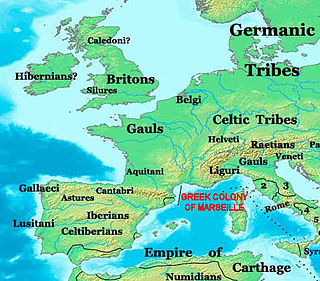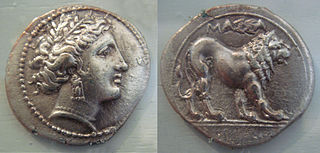The Allobroges were a Gallic people dwelling in a large territory between the Rhône river and the Alps during the Iron Age and the Roman period.

Phocaea or Phokaia was an ancient Ionian Greek city on the western coast of Anatolia. Greek colonists from Phocaea founded the colony of Massalia in 600 BC, Emporion in 575 BC and Elea in 540 BC.
The Deciates (Δεκιήταις) were a Ligurian tribe dwelling near on the Mediterranean coast, around present-day Antibes, during the Iron Age and the Roman era.
The Oxybii or Oxubii were a Celto-Ligurian tribe dwelling on the Mediterranean coast during the Iron Age and the Roman period.

The naval Battle of Alalia took place between 540 BC and 535 BC off the coast of Corsica between Greeks and the allied Etruscans and Carthaginians. A Greek force of 60 Phocaean ships defeated a Punic-Etruscan fleet of 120 ships while emigrating to the western Mediterranean and the nearby colony of Alalia.
The Reii were a Celto-Ligurian tribe dwelling in the modern department of Alpes-de-Haute-Provence during the Iron Age and the Roman period.
The Salyes or Salluvii were an ancient Celto-Ligurian people dwelling between the Durance river and the Greek colony of Massalia during the Iron Age. Although earlier writers called them 'Ligurian', Strabo used the denomination 'Celto-ligurian' in the early 1st century AD. A Celtic influence is noticeable in their religion, which centred on the cult of the tête coupée, as well as in the names of their towns and leaders. During the 2nd century BC, the Salyes were most likely at the head of a political and military confederation that united both Gallic and Ligurian tribes.
The Vocontii were a Gallic people dwelling on the western foothills of the Alps during the Iron Age and the Roman period.

The Cavarī or Cavarēs were a Gallic tribe dwelling in the western part of modern Vaucluse, around the present-day cities of Avignon, Orange and Cavaillon, during the Roman period. They were at the head of a confederation of tribes that included the Tricastini, Segovellauni and Memini, and whose territory stretched further north along the Rhône Valley up to the Isère river.
The Tricastini were a small Gallic tribe dwelling in the modern Tricastin region, near present-day Saint-Paul-Trois-Châteaux, during the Iron Age and the Roman period.

The Greeks in pre-Roman Gaul have a significant history of settlement, trade, cultural influence, and armed conflict in the Celtic territory of Gaul, starting from the 6th century BC during the Greek Archaic period. Following the founding of the major trading post of Massalia in 600 BC by the Phocaeans at present day Marseille, Massalians had a complex history of interaction with peoples of the region. Large Greek colonies also existed west of the Rhône, particularly at Agde and Béziers, the latter of which both predates, and was larger than, the Marseille colony.
The Helvii were a relatively small Celtic polity west of the Rhône river on the northern border of Gallia Narbonensis. Their territory was roughly equivalent to the Vivarais, in the modern French department of Ardèche. Alba Helviorum was their capital, possibly the Alba Augusta mentioned by Ptolemy, and usually identified with modern-day Alba-la-Romaine. In the 5th century the capital seems to have been moved to Viviers.
The Battle of Vindalium took place near Vindalium, a Cavarian settlement probably corresponding to modern day Mourre-de-Sève in Sorgues, near the confluence of the Rhône and Durance rivers in Southern France. The battle opposed the Allobroges, a Gallic tribe dwelling further north between the Rhône and the Alps, to the Roman forces of proconsul Gnaeus Domitius Ahenobarbus.
The Avatici were a Gallic tribe dwelling near the Étang de Berre, between the mouth of the Rhône river and Massilia, during the Roman period.

Marseille, France was originally founded circa 600 BC as the Greek colony of Massalia and populated by Greeks from Phocaea. It became the preeminent Greek polis in the Hellenized region of southern Gaul. The city-state allied with the Roman Republic against Carthage during the Second Punic War, retaining its independence and commercial empire throughout the western Mediterranean even as Rome expanded into Western Europe and North Africa. However, the city lost its independence following the Roman Siege of Massilia in 49 BC, during Caesar's Civil War, in which Massalia sided with the exiled faction at war with Julius Caesar.

Massalia was an ancient Greek colony (apoikia) on the Mediterranean coast, east of the Rhône. Settled by the Ionians from Phocaea in 600 BC, this apoikia grew up rapidly, and its population set up many outposts for trading in modern-day Spain, Corsica and Liguria. Massalia persisted as an independent colony until the Roman campaign in Gaul in the 1st Century BC. The ruins of Massalia still exist in the contemporary city of Marseille, which is considered the oldest city of France and one of Europe's oldest continuously inhabited settlements.
The Vediantii were a Celto-Ligurian tribe dwelling on the Mediterranean coast, near present-day Nice, during the Iron Age and the Roman period.
The Ingauni were a Celto-Ligurian tribe dwelling on the Mediterranean coast, around the modern city of Albenga (Liguria), during the Iron Age and the Roman period.

The founding myth of Marseille is an ancient creation myth telling the legendary foundation of the colony of Massalia, on the Mediterranean coast of what was later known as southern Gaul, by Greek settlers from Phocaea, a city in western Anatolia. Although the attested versions differ on some details, they all recount the story of the marriage of the princess Gyptis, the daughter of Nannus, chief of the native Segobrigii, to the Phocaean sailor Protis. On her wedding day, the princess chooses to marry the foreigner by giving him a bowl filled with wine or water during the feast.
The Protiadae were a prominent Massaliote family. The family probably claimed descent from the Phocaean Greek Prō̃tis (Πρῶτις), a legendary figure said to be the son of Euxenus, a Phocaean founder of Massalia, in one account and to have himself founded the city in another. Aristotle reported that the family was still present in the area in his time.
![Fondation de Marseille by Francois Gilbert [fr] (1816-1891). Palais de la Bourse, Marseille. Marseille Bourse interieur sculpture voussure 2.jpg](http://upload.wikimedia.org/wikipedia/commons/thumb/5/5a/Marseille_Bourse_int%C3%A9rieur_sculpture_voussure_2.jpg/220px-Marseille_Bourse_int%C3%A9rieur_sculpture_voussure_2.jpg)







